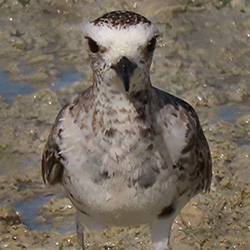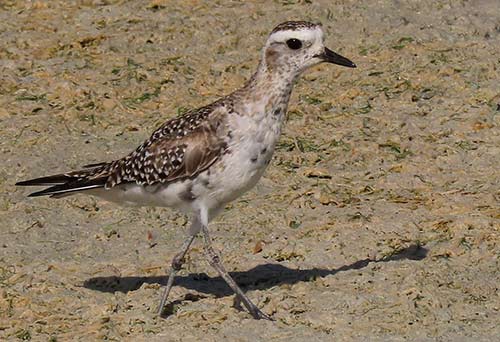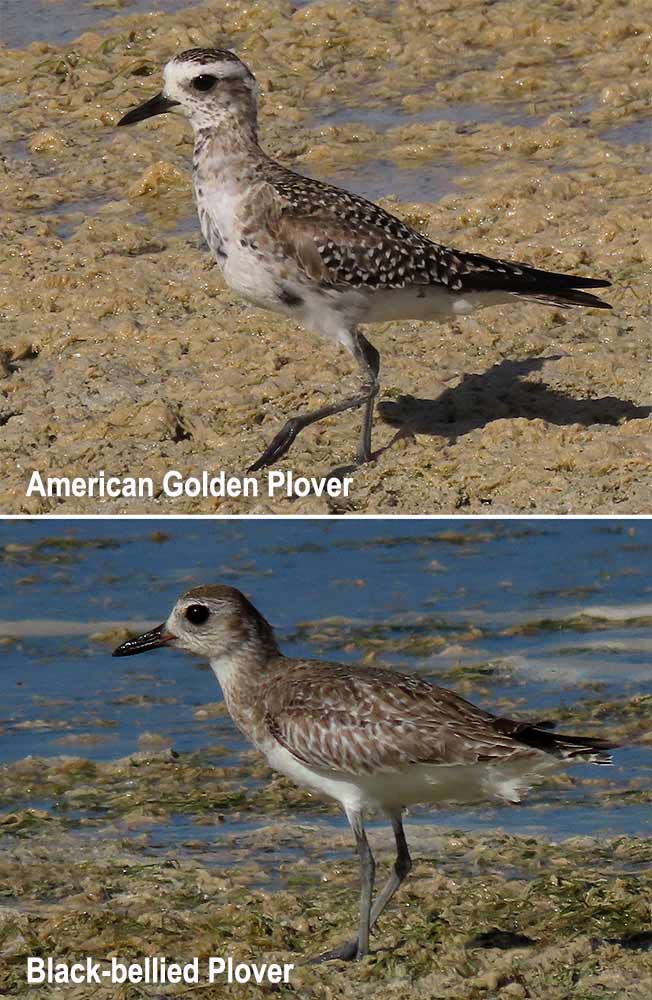American Golden Plover in Bonaire Spring Migration
An unusual sighting for Bonaire’s spring migration!
Posted April 23, 2021
Spring migration surprises Bonaire with the visit of an American Golden Plover.
With the spring migration season well underway, birders on Bonaire are seeing some great sightings, such as a Northern Parula and even a Scarlet Tanager in bright red breeding plumage! But a bird which was not expected has just been observed, the American Golden Plover!
While birding this week, I came across this beautiful gold-flecked bird. With its very distinctive fluffy white eyebrows, it’s quite a fetching bird. Using my car as a blind, I was able to observe it for several minutes, as it foraged about 3-4 meters (10-12 feet) away from me.
Similar species to the American Golden Plover.
At first glance, the American Golden Plover might be misidentified as the Black-bellied Plover, normally seen here on Bonaire in its winter plumage. Much more common, the Black-bellied Plover can be observed in different habitats around Bonaire.
As the graphic illustrates, the American Golden Plover and the Black-bellied Plover (both in winter plumage) look a great deal alike. Distinguishing features of the American Golden Plover are its overall more golden color (instead of brown or gray), and the upper parts are brown, speckled with gold. At rest, its wingtips extend beyond the tip of the tail. One way to ensure your identity is to observe it in flight. The Black-bellied Plover exhibits a “black armpit” while the American Golden Plover does not. Of course, hearing its call is always an excellent way to identify your bird. The American Golden Plover gives a two-syllable whistle, weedletee.
Why is it unusual to see an American Golden Plover during spring migration on Bonaire?
Prior recorded sightings of the American Golden Plover on Bonaire.
In checking prior recorded sightings of the American Golden Plover on Bonaire via eBird, the oldest record was from September 26, 1997, nearly 24 years ago. (Note: Additional sightings have been recorded on Observado.) Utilizing data from eBird, the species was not sighted again until the autumn of 2016. Since 2016, there have been just 15 additional records since the first sighting. And what is most important, all but one have been during the fall migration!
Different routes for different birds.
Many of the Caribbean’s migratory birds have a distinct route, or perhaps two. Although they may stray a bit from these established routes, going south for the winter and north for the summer, they usually don’t stray very far. The American Golden Plover likes to be different.
The southern migration (fall) of the American Golden Plover.
In the case of the American Golden Plover, when the temperature starts to plummet in their cold, northern Arctic breeding grounds, the birds will answer the call of warmer climes and begin their fall migration to South America. Many consider the American Golden Plover as one of the fastest-flying shorebirds, capable of reaching speeds up to 96 kilometers per hour (60 miles per hour). During the fall, some will utilize a nonstop trans-Atlantic route, while others utilize a trans-Gulf of Mexico route or trans-Caribbean pathway. This is why most of Bonaire’s sightings occur during fall migration as the birds rest and feed before heading on to their wintering grounds in South America.
Spring migration is another story, as the majority of American Gold Plovers will utilize a totally different flight path in the spring months.
The northern migration (spring) of the American Golden Plover.
Spring migration can begin in the interior of South America in late January, with the majority of American Golden Plovers on the move in February. Late stragglers can begin leaving for the north as late as April.
Returning north via an inland passage in Brazil normally cannot be utilized in the spring months, as the migration coincides with cyclical flooding in much of the interior of that country, making passage through the previously used fall flight areas impossible. Instead, it appears that the American Golden Plover makes use of a different flight path for its northern migration, utilizing the upper reaches of the Amazon River basin in Bolivia, Peru, and Colombia to gather and stage a departure that tracks along the coasts of Central America and Mexico.
Although it is thought that most American Golden Plovers utilize this return path using Central America to North America, there are some birds that fly directly across the Caribbean and the Gulf of Mexico. Although fewer in number, most likely this week’s sighting of an American Golden Plover on Bonaire signifies the bird will complete its northward flight straight across the Caribbean.
It is interesting to note that back in September 2019, I also saw an American Golden Plover in nearly the identical spot, while it rested and recovered during its southern trek. Could this be the same individual? Don’t you wish it could tell us?

American Golden Plover
(Pluvialis dominica)
Diet: Invertebrates, primarily terrestrial, some freshwater and marine; also berries, leaves, and seeds
Breeding: Lays 4 eggs
Status: Least Concern
About the author:
 Susan has been living on Bonaire for over 30 years. She is a certified bird guide, as well as a topside and underwater photographer. She is a 2016 graduate of the Caribbean Birding Trail Interpretive Guide Course conducted by BirdsCaribbean.
Susan has been living on Bonaire for over 30 years. She is a certified bird guide, as well as a topside and underwater photographer. She is a 2016 graduate of the Caribbean Birding Trail Interpretive Guide Course conducted by BirdsCaribbean.
Get in touch with Susan
Contact Susan via email, Facebook Messenger, call Susan or use the online form below.
If you have any questions about your Bonaire birding tour, feel free to contact Susan for answers. She is always willing to go into more detail about routes or the best times for a tour based on your personal preferences. Tours can be tailored to your interests, whether that be birds, photography, or both!
It is also a good idea to do some homework on the birds of Bonaire before you come. Knowing a little about the birds you might encounter on your tour will make your experience even more enjoyable!
Be sure to check out these resources for birding on Bonaire. Also, reading the Bird Blog will introduce you to the birds that might be observed on Bonaire.
Get In Touch
Get in touch with Susan to check availability for the dates you are visiting Bonaire.
Consent: By using this form you agree with the storage and handling of your data by this website.







